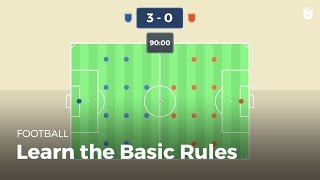Football Rules: A Beginner’s Guide
Football, also known as soccer in some countries, is a popular sport played by millions around the world. To fully enjoy and appreciate the game, it’s important to understand the basic rules that govern it. Here are some key football rules that every fan should know:
The Objective
The objective of football is simple: to score goals by getting the ball into the opposing team’s goal. The team with the most goals at the end of the match wins.
Players and Positions
A standard football team consists of 11 players, including a goalkeeper. Players are assigned specific positions such as defenders, midfielders, and forwards, each with their own roles and responsibilities on the field.
Duration of the Game
A standard football match consists of two halves, each lasting 45 minutes, with a 15-minute halftime break. In case of a tie at the end of regulation time, extra time or a penalty shootout may be used to determine the winner.
Offside Rule
One of the most debated rules in football is the offside rule. A player is in an offside position if they are closer to the opponent’s goal line than both the ball and the second-last opponent when the ball is played to them.
Fouls and Misconduct
Fouls are penalised by free kicks or penalty kicks depending on where they occur on the field. Yellow cards are shown for minor offences, while red cards result in a player being sent off for serious misconduct.
The Penalty Kick
A penalty kick is awarded for certain fouls committed inside the penalty area. It gives a player an opportunity to score directly against only the goalkeeper from 12 yards out.
These are just a few of the many rules that govern football matches. Understanding and appreciating these rules can enhance your enjoyment of this beautiful game!
Understanding Key Football Rules: Offside, Handball, Yellow Cards, Penalty Kicks, and Throw-Ins
Offside rule
In football, the offside rule is a crucial aspect of the game that often sparks debates among players and fans alike. A player is deemed to be in an offside position if they are closer to the opponent’s goal line than both the ball and the second-last opponent when the ball is played to them. This rule is in place to prevent attacking players from gaining an unfair advantage by positioning themselves behind the last line of defenders. Understanding and interpreting the offside rule correctly can significantly impact a team’s attacking strategy and overall performance on the field.
Handball rule
The handball rule in football is a crucial aspect that often sparks debate and controversy. According to the rule, a player is not allowed to deliberately handle the ball with their hand or arm, except for the goalkeeper within their own penalty area. If a player handles the ball intentionally, a direct free kick or penalty kick may be awarded to the opposing team, depending on where the offence occurred. The interpretation of handball incidents can vary, leading to heated discussions among players, coaches, and fans. Understanding the handball rule is essential for players to avoid committing fouls and for spectators to appreciate fair play in the game.
Yellow card
In football, a yellow card is shown by the referee to a player as a cautionary measure for committing a foul or unsporting behaviour. It serves as a warning to the player that further misconduct could result in a red card and expulsion from the game. A yellow card can have consequences beyond the match, as accumulating multiple yellow cards over several games may lead to suspension. Players must be mindful of their actions on the field to avoid receiving a yellow card and potentially putting their team at a disadvantage.
Penalty kick
A penalty kick is a crucial moment in a football match, awarded for certain fouls committed inside the penalty area. It presents a unique opportunity for a player to take a shot at goal from 12 yards out, with only the goalkeeper to beat. The pressure is high, as the success of a penalty kick can often determine the outcome of a game. It requires skill, composure, and precision to convert a penalty kick successfully, making it one of the most intense and exciting moments in football.
Throw-in rule
In football, the throw-in rule is a crucial aspect of the game that comes into play when the ball goes out of bounds over the touchline. When this happens, the team that did not touch the ball last is awarded a throw-in. The player taking the throw-in must have both feet on or behind the touchline and use both hands to deliver the ball back into play from above their head. The thrower must keep both feet on the ground and maintain proper distance from the touchline. Understanding and executing the throw-in rule correctly can provide a strategic advantage to a team by maintaining possession or creating goal-scoring opportunities.
Tags: duration, football, football rules, fouls, game, handball rule, misconduct, objective, offside rule, penalty kick, players, positions, rules, yellow card
